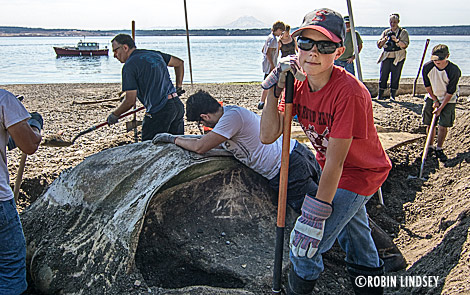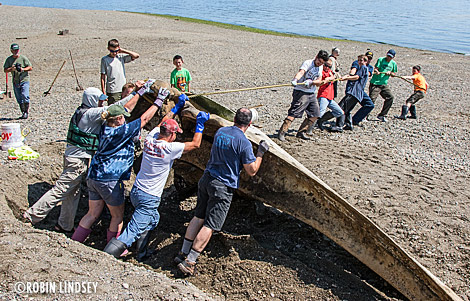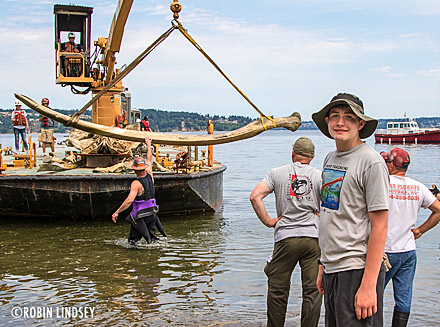Burien fin whale skeleton gets new life for public display
Jun/28/15 06:50 AM

The endangered whale was killed by a ship strike, likely brought into Puget Sound on the bow of a large ship, and floated ashore at Burien’s Seahurst Park in April of 2013. Seal Sitters volunteers assisted in crowd control as hordes of people flocked to the park to view the second largest species of whale - and animal - in the world. Following a limited necropsy by Cascadia Research Collective and Washington Department of Fish and Wildlife/Marine Mammal Investigations Unit, the carcass was towed to a South Puget Sound island for further examination and left to naturally decompose on the remote beach.
Next began the search to find an institution interested in the bones for an educational display. Foss Waterway Seaport, located on Tacoma’s waterfront, jumped at the opportunity to feature the huge skull and other bones at their museum. Although the skeleton was incomplete because the whale was literally cut in half by the ship, Seaport Director of Education, Jan Adams, believed the skull would prove a wonderful learning experience.
Brainstorming with her 14-year old son Gregg about possible Eagle Scout service projects, WDFW’s marine mammal biologist Dyanna Lambourn asked if he might want to lead his troop in unearthing the whale. Gregg presented the idea to his fellow Scouts who enthusiastically agreed to help with the unique endeavor. After substantial planning, the complex service project was approved by leadership in the Chief Seattle Council. In 2013 alone, members of the Boy Scouts of America, working toward achieving the rank of Eagle Scout, donated 9.3 million service hours on projects that benefited communities across the country.
On Friday night, 6 Scout team leaders (along with the Scoutmaster and adult leaders) camped out in the woods of the island, preparing for the big dig. In the early morning light, the remaining 5 Scouts from the troop (ages 11-14) were shuttled across the water from Fox Island by WDFW in a pair of sturdy Boston Whaler research boats. A handful of volunteers from Highline College’s Marine and Science Technology (MaST) later arrived with Foss Waterway staff on a refurbished U.S. Coast Guard research vessel which chugged all the way from Tacoma. Eggs were scrambled for breakfast burritos and coolers full of water, Gatorade and food for the day were lined up for the crew.

The team tugged and pushed the estimated 1,000 lb skull and its lower two jaws, each weighing more than 500 lbs, to the water’s edge. A barge from Nisqually Marine Services, requiring only an 18” depth of water and equipped with a crane, raised the mammoth bones up onto the deck for transport to the museum where they will be scrubbed clean, dried and prepped for exhibition.

Once on display at Foss Seaport Waterway’s museum (hopefully by late July), the bone artifacts will educate scores of visitors about majestic fin whales - and the increasing dangers of ship strikes to the many species of whales who migrate along our Pacific Coast.







